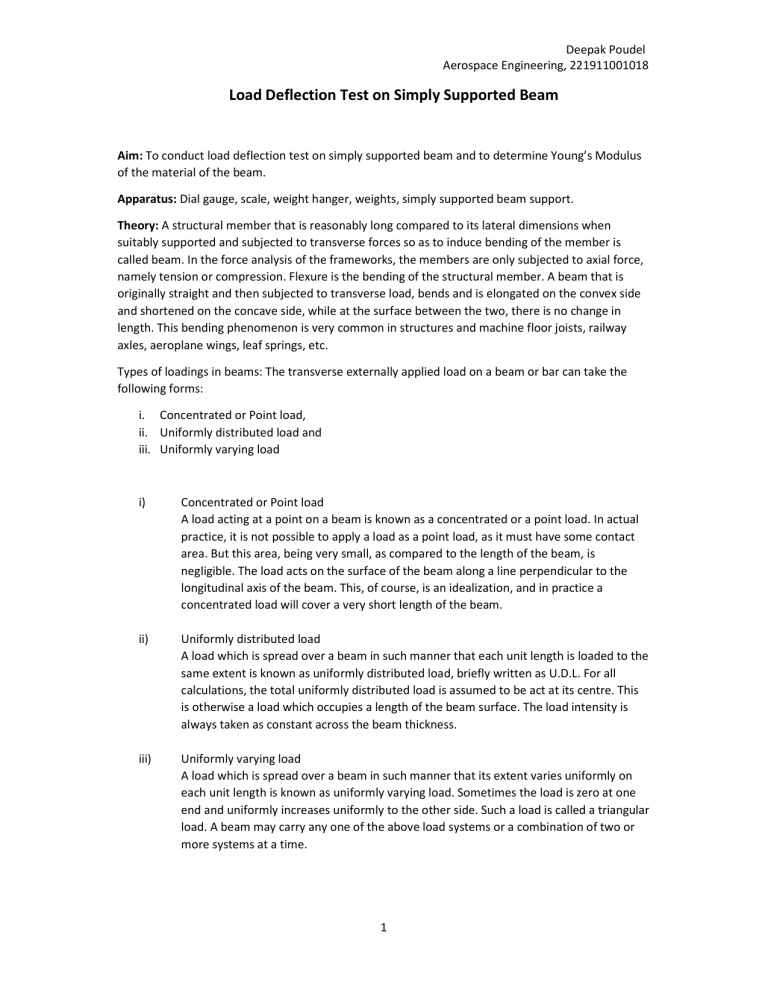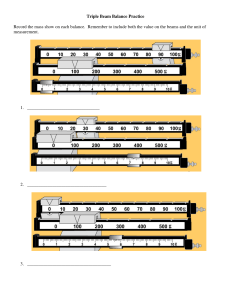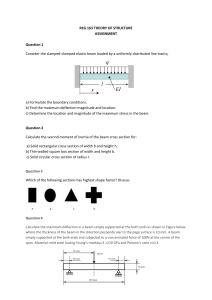
Deepak Poudel Aerospace Engineering, 221911001018 Load Deflection Test on Simply Supported Beam Aim: To conduct load deflection test on simply supported beam and to determine Young’s Modulus of the material of the beam. Apparatus: Dial gauge, scale, weight hanger, weights, simply supported beam support. Theory: A structural member that is reasonably long compared to its lateral dimensions when suitably supported and subjected to transverse forces so as to induce bending of the member is called beam. In the force analysis of the frameworks, the members are only subjected to axial force, namely tension or compression. Flexure is the bending of the structural member. A beam that is originally straight and then subjected to transverse load, bends and is elongated on the convex side and shortened on the concave side, while at the surface between the two, there is no change in length. This bending phenomenon is very common in structures and machine floor joists, railway axles, aeroplane wings, leaf springs, etc. Types of loadings in beams: The transverse externally applied load on a beam or bar can take the following forms: i. Concentrated or Point load, ii. Uniformly distributed load and iii. Uniformly varying load i) Concentrated or Point load A load acting at a point on a beam is known as a concentrated or a point load. In actual practice, it is not possible to apply a load as a point load, as it must have some contact area. But this area, being very small, as compared to the length of the beam, is negligible. The load acts on the surface of the beam along a line perpendicular to the longitudinal axis of the beam. This, of course, is an idealization, and in practice a concentrated load will cover a very short length of the beam. ii) Uniformly distributed load A load which is spread over a beam in such manner that each unit length is loaded to the same extent is known as uniformly distributed load, briefly written as U.D.L. For all calculations, the total uniformly distributed load is assumed to be act at its centre. This is otherwise a load which occupies a length of the beam surface. The load intensity is always taken as constant across the beam thickness. iii) Uniformly varying load A load which is spread over a beam in such manner that its extent varies uniformly on each unit length is known as uniformly varying load. Sometimes the load is zero at one end and uniformly increases uniformly to the other side. Such a load is called a triangular load. A beam may carry any one of the above load systems or a combination of two or more systems at a time. 1 Deepak Poudel Aerospace Engineering, 221911001018 Types of Supports: Theoretical solutions of beam problems generally employ two simplified forms of supports. They are termed simply supported and built-in or fixed i) Simple support: A simple support can otherwise be termed as hinged support. Once again hinged support is subclassified into a) Movable hinged support b) Immovable hinged support a) Movable hinged support: If one end of a beam is supported in a movable hinged support it is free to rotate about the hinge, and the translation displacement along the plane of rolling is possible. b) Immovable hinged support: If the ends of a beam are supported on an immovable hinged support, the ends of the beams are free to rotate but translation displacement is not possible in any direction. c) Built in or Fixed Support: If the end of a beam is fixed, that end is neither free to rotate nor free to have translation displacement. Procedure: 1. The length and cross-sectional dimensions of the beam are measured. 2. The weight hanger is placed at the midspan of the beam. 3. The dial gauge is arranged such that the pointer touches the bottom surface of the beam at the centre. 4. The dial gauge is adjusted to zero and weights are placed on the weight hanger from 500 grams to 3500 grams in intervals of 500 grams 5. The readings of the dial gauge are recorded in a tabular form. 6. The corresponding readings of the dial gauge are tabulated. Formula and Given data: i) The maximum amount of deflection (𝛿) in a simply supported beam is given by the formula: 𝛿= where, W = Load acting at the centre, N L = Length of the beam between the supports mm E = Young’s Modulus of material of the beam, N/mm2 I = Second moment of area of the cross-section (i.e, moment of inertia) of the beam, about the neutral axis, mm4. ii) The moment of inertia of the beam is calculated by using the formula: 2 Deepak Poudel Aerospace Engineering, 221911001018 I= where, b = breadth of the beam cross-section d = depth of the beam cross-section iii) Similarly, the given values for the beam are: b = 40 mm, d = 6 mm, L = 1170 mm from which we can calculate the moment of inertia of the experimented beam. From the formula (ii), It was found to be 720mm 4. Now rearranging the equation given in i. and inserting the given values and the value of deflection (𝛿), we can calculate the Young’s modulus of the material of the beam. Observations: The values of the deflection are obtained from experiment and thus the value of ‘E’ is calculated for different loads and corresponding deflection using the above equation (i) and the result obtained is tabulated below: S.N Load (kg) 1. 2. 3. 4. 5. 6. 0.27 0.46 0.66 0.88 1.105 1.335 Loading 𝛿 0.51 0.91 1.34 1.74 2.21 2.71 Dial Gauge reading Unloading 𝛿 Avg. deflection 0.51 0.51 0.92 0.915 1.35 1.345 1.80 1.77 2.27 2.24 2.71 2.71 E (N/m2) 2.40 X 105 2.31 X 105 2.24 X 105 2.26 X 105 2.24 X 105 2.71 X 105 Graph: The load vs. deflection graph is plotted using the tabulated data with load on the x-axis and deflection on y-axis. The graph shows the linear variation of deflection of the beam with the variation in the load that the beam is subjected to. Load vs Deflection Graph 3 deflection 2.5 2 1.5 1 0.5 0 0 0.2 0.4 0.6 0.8 1 1.2 1.4 1.6 load Result: From the Load deflection experiment, the average value of Young’s Modulus is found to be 2.36 X 105 N/mm2. 3




